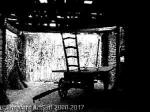Harry Bertoia
Harry Bertoia
Place: San Lorenzo
Born: 1915
Death: 1978
Biography:
Harry Bertoia During this period he designed five wire pieces that became known as the Bertoia Collection for Knoll. Among these was the famous diamond chair, a fluid, sculptural form made from a welded lattice work of steel.
In Bertoia's own words, "If you look at these chairs, they are mainly made of air, like sculpture. Space passes right through them."
The chairs were produced with varying degrees of upholstery over their light grid-work, and they were handmade at first because a suitable mass production process could not be found. Unfortunately, the chair edge utilized two thin wires welded on either side of the mesh seat. This design had been granted a patent to the Eames for the wire chair produced by Herman Miller. Herman Miller eventually won and Bertoia & Knoll redesigned the seat edge, using a thicker, single wire, and grinding down the edge of the seat wires at a smooth angle—the same way the chairs are produced today. Nonetheless, the commercial success enjoyed by Bertoia's diamond chair was immediate. It was only in 2005 that Bertoia's asymmetrical chaise longue was introduced at the Milan Furniture Fair and sold out immediately.
In the mid-1950s, the chairs being produced by Knoll sold so well that the lump sum payment arrangement from Knoll allowed Bertoia to devote himself exclusively to sculpture. He ultimately produced over 50 commissioned public sculptures, many of which are still viewable today. In the 1960s, he began experimenting with sounding sculptures of tall vertical rods on flat bases. He renovated the old barn into an atypical concert hall and put in about 100 of his favorite "Sonambient" sculptures.Bertoia played the pieces in a number of concerts and even produced a series of eleven albums, all entitled "Sonambient," of the music made by his art, manipulated by his hands along with the elements of nature. In the late 1990s, his daughter found a large collection of near mint condition original albums stored away on his property in Pennsylvania. These were sold as collector's items. In 2015, these Sonambient recordings are being re-issued by Important Records as a box set with a booklet of the history and previously unseen photos.Bertoia's work can be found in The Addison Gallery of American Art (Andover, Massachusetts), the Brooklyn Museum (New York City), the Cleveland Museum of Art, the Dallas Public Library, the Detroit Institute of Arts, the Hirshhorn Museum and Sculpture Garden (Washington D.C.), the Honolulu Museum of Art, the Kemper Museum of Contemporary Art (Kansas City, Missouri), the Nasher Sculpture Center (Dallas, Texas), the Philadelphia Museum of Art, the Reading Public Museum (Reading, Pennsylvania), the Allentown Art Museum, Milwaukee art museum, the Smithsonian American Art Museum (Washington D.C.), the Vero Beach Museum of Art (Vero Beach, Florida), and the Walker Art Center (Minneapolis, Minnesota).
Bertoia's "Sunburst Sculpture" owned by the Joslyn Art Museum was originally installed in the Joslyn's Fountain Court. It is now located in the lobby of the Milton R. Abrahams Branch of the Omaha Public Library. Lord Palumbo owns several Bertoia works which are on display at Kentuck Knob. Bertoia's "Sounding Sculpture" can be found in the plaza of The Aon Center, Chicago's third tallest building. Another "Sounding Sculpture", considerably smaller than the one mentioned above, is featured in the Rose Terrace of the Chicago Botanic Garden, and a third very similar to the piece in Chicago called "Sounding Piece" was until 2003 on display at the Herbert F. Johnson Museum of Art at Cornell University in Ithaca, New York. As explained in October 3, 1995 piece in the weekly "Dear Uncle Ezra" column of the university newspaper:
More...
Wikipedia link: Click Here














